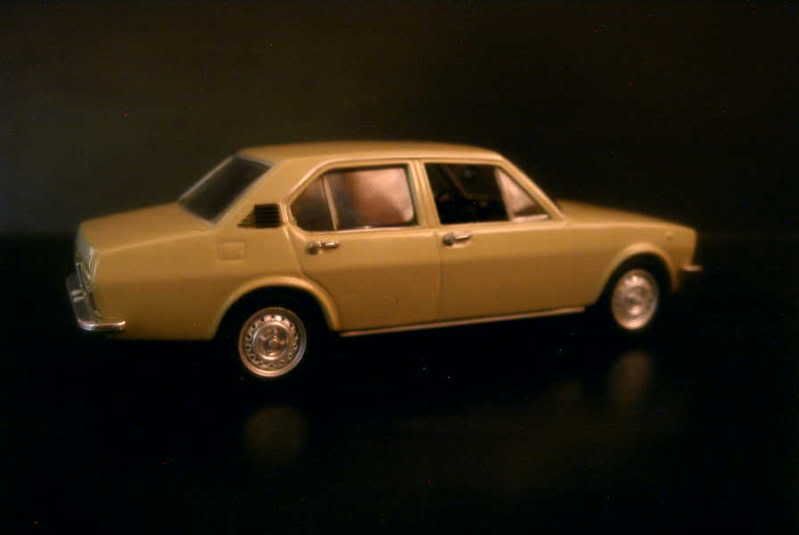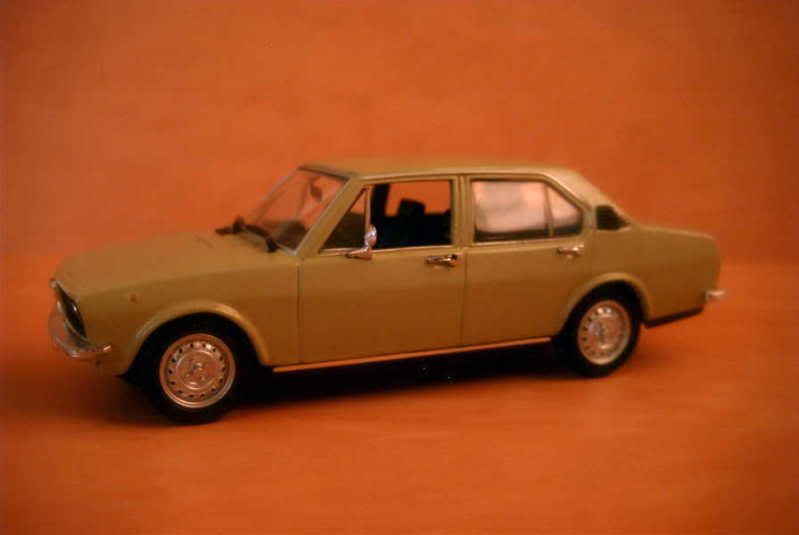Same company, same era, but a little higher in the range.
A little history
In 1971, Alfa Romeo introduced a very modern compact car: the Alfasud. The Italian manufacturer never intended to extend its boldness to the higher models of its range, though. One year later, the Alfetta was presented, positioned just a notch above the ageing Giulia, which was kept in production. Penned by Giuseppe Scarnati, its body was indeed elegant, but tame. There was no surprise under this skin: the transmission was to the rear wheels, and the suspension (double wishbones and torsion bars) was perhaps independent at the front, but a solid axle was fitted at the rear. The engine was brilliant yet again, not revolutionary: it was a 1.8-litre, 4-cylinder double overhead camshaft with two valves per cylinder, fed by two double-barrel carburettors. On the road, the Alfetta was soon praised for its very sane behaviour. Furthermore, the enviable image the brand had developed helped a lot to make the car a commercial success.
Alfa Romeo’s aura would not last, however. Quality problems and fragile mechanicals parts would see to this. Besides, the rust problems that affected the entry-level Alfasud would soon spread to all Alfa models. The cause: the Italian government had signed an agreement with the Soviet Union, one of its effects being the import of large quantities of Soviet steel to feed the Italian industry. This steel was actually recycled and of poor quality; the standard of the Italian cars production plummeted.
The Giulia’s ultimate retirement brought about the extension of the Alfetta’s range. A smaller 1.6-litre twin-cam engine was offered for the 1975 model year, while a splendid coupe penned by Giorgetto Giugiaro in collaboration with Alfa’s own designers, the GT, had been introduced early in 1974. The GT, which would become the GTV in 1976, inherited all the qualities of the saloon. With perfect handling and 140 bhp under the bonnet, the GT was soon seen campaigning in touring cars racing and rallies, but success was moderate.
New models were regularly added to the line-up, including a 2.0-litre engine in 1976, and another 2.0-litre, a turbocharged diesel this time, three years later. During the very same year 1979, the Alfetta saloon received a revised front end. The major news of the year was nonetheless the introduction of the GTV 6 for 1980. Alfa Romeo had launched a luxury sedan which, from the very start, proved to be a catastrophe. The best this Alfa 6 had to offer was its 2.5-litre V6, though in the saloon it was handicapped by recurrent carburettor problems. The engine was grafted onto the GTV, creating a potent combination. The GTV 6 was immediately homologated for racing, where it immediately proved its worth.
After 1979, modifications were scarce as the Alfetta was coasting towards its retirement. This came in 1984, shortly before being succeeded by the Alfa 75. No replacement had been scheduled for the GTV, though, and, helped by its late-career successes on the track, the stunning coupe lingered on for two more years.
Model: Alfa Romeo Alfetta 1.6
Year: 1975
Maker: Minichamps
Scale: 1/43
Distributed by: Minichamps ref. 400-120201, limited edition - 2,544 pieces
Acquired: brand new, in May 2006, in Manila, Philippines
Minichamps also signed the bigger sister of the Alfasud. The model is correct, but nothing more. I cannot tell exactly what I dislike about it. Is that its colour, sable or giallo piper as suggested by the German manufacter, certainly authentic, but undoubtedly dated more than three decades later? Is this the vents on the C-pillars, which have been clumsily done? Could it be these thick black plastic windshield wipers? About the latter, I already said how undeserving they are on a model of the quality - and the price - of a Minichamps. I'll limit my rating to 12/20.




A little history
In 1971, Alfa Romeo introduced a very modern compact car: the Alfasud. The Italian manufacturer never intended to extend its boldness to the higher models of its range, though. One year later, the Alfetta was presented, positioned just a notch above the ageing Giulia, which was kept in production. Penned by Giuseppe Scarnati, its body was indeed elegant, but tame. There was no surprise under this skin: the transmission was to the rear wheels, and the suspension (double wishbones and torsion bars) was perhaps independent at the front, but a solid axle was fitted at the rear. The engine was brilliant yet again, not revolutionary: it was a 1.8-litre, 4-cylinder double overhead camshaft with two valves per cylinder, fed by two double-barrel carburettors. On the road, the Alfetta was soon praised for its very sane behaviour. Furthermore, the enviable image the brand had developed helped a lot to make the car a commercial success.
Alfa Romeo’s aura would not last, however. Quality problems and fragile mechanicals parts would see to this. Besides, the rust problems that affected the entry-level Alfasud would soon spread to all Alfa models. The cause: the Italian government had signed an agreement with the Soviet Union, one of its effects being the import of large quantities of Soviet steel to feed the Italian industry. This steel was actually recycled and of poor quality; the standard of the Italian cars production plummeted.
The Giulia’s ultimate retirement brought about the extension of the Alfetta’s range. A smaller 1.6-litre twin-cam engine was offered for the 1975 model year, while a splendid coupe penned by Giorgetto Giugiaro in collaboration with Alfa’s own designers, the GT, had been introduced early in 1974. The GT, which would become the GTV in 1976, inherited all the qualities of the saloon. With perfect handling and 140 bhp under the bonnet, the GT was soon seen campaigning in touring cars racing and rallies, but success was moderate.
New models were regularly added to the line-up, including a 2.0-litre engine in 1976, and another 2.0-litre, a turbocharged diesel this time, three years later. During the very same year 1979, the Alfetta saloon received a revised front end. The major news of the year was nonetheless the introduction of the GTV 6 for 1980. Alfa Romeo had launched a luxury sedan which, from the very start, proved to be a catastrophe. The best this Alfa 6 had to offer was its 2.5-litre V6, though in the saloon it was handicapped by recurrent carburettor problems. The engine was grafted onto the GTV, creating a potent combination. The GTV 6 was immediately homologated for racing, where it immediately proved its worth.
After 1979, modifications were scarce as the Alfetta was coasting towards its retirement. This came in 1984, shortly before being succeeded by the Alfa 75. No replacement had been scheduled for the GTV, though, and, helped by its late-career successes on the track, the stunning coupe lingered on for two more years.
Model: Alfa Romeo Alfetta 1.6
Year: 1975
Maker: Minichamps
Scale: 1/43
Distributed by: Minichamps ref. 400-120201, limited edition - 2,544 pieces
Acquired: brand new, in May 2006, in Manila, Philippines
Minichamps also signed the bigger sister of the Alfasud. The model is correct, but nothing more. I cannot tell exactly what I dislike about it. Is that its colour, sable or giallo piper as suggested by the German manufacter, certainly authentic, but undoubtedly dated more than three decades later? Is this the vents on the C-pillars, which have been clumsily done? Could it be these thick black plastic windshield wipers? About the latter, I already said how undeserving they are on a model of the quality - and the price - of a Minichamps. I'll limit my rating to 12/20.







No comments:
Post a Comment